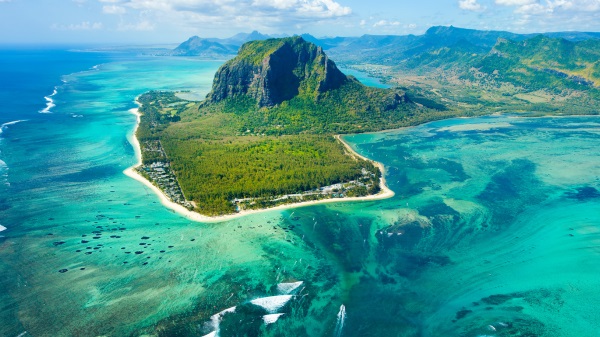Environment
Rising Seas Not Resulting in Disappearing Islands

From Heartland Daily News
A spate of recent articles acknowledges a fact that Climate Realism has long discussed. Most island nations, rather than sinking beneath the waves as seas rise amid modest warming, as predicted by climate alarmists and island profiteers, are, in fact growing.
Writing for The Pipeline, Buck Throckmorton thoroughly debunks claims that recent collapses of houses built on the shores of barrier islands in North Carolina were caused by climate change:
[B]arrier islands … are impermanent deposits of sand, which reshape, move, merge, appear, and disappear due to tides, winds, and storms.
The movement of barrier islands is not due to rising sea levels, it is due to a naturally occurring force called “longshore drift.” Where there are man-made efforts to stabilize barrier islands with jetties and sea walls, this produces other impacts on currents that cause erosion in some waterfront areas and new sand deposits in others. Beach houses in the Outer Banks are not being lost due to rising sea levels, they are being lost due to shifting sands.
Throckmorton also pointed to the disappearance of Tucker’s Island, off the coast of New Jersey, which completely disappeared due to “long-shore drift,” not rising seas.
NOAA describes the impact of long-shore drift, thusly:
Longshore drift may also create or destroy entire barrier islands along a shoreline. A barrier island is a long offshore deposit of sand situated parallel to the coast. As longshore drifts deposit, remove, and redeposit sand, barrier islands constantly change.
Semi-permanent, shifting barrier islands are not the only types of islands not being destroyed by climate change-induced rising seas. Even The New York Times (NYT) was recently forced by reality to admit that coral atolls, long the poster child of rising seas claiming nations, have been expanding and adding land amidst the Earth’s slight recent warming.
As recently as April 2024, with a story titled “Why Time Is Running Out Across the Maldives’ Lovely Little Islands,“ the NYT was still pushing the lie that rising seas threaten dozens of island nations, consisting of hundreds of small coral atolls, with extinction. Reality forced the NYT to reverse itself in the space of just three months. The author of a late June article, “A Surprising Climate Find,” wrote:
Of late, though, scientists have begun telling a surprising new story about these islands. By comparing mid-20th century aerial photos with recent satellite images, they’ve been able to see how the islands have evolved over time. What they found is startling: Even though sea levels have risen, many islands haven’t shrunk. Most, in fact, have been stable. Some have even grown.
The problem with this narrative is that the fact of growing islands during the recent period of climate change is not new news. In fact, as my colleague Linnea Lueken noted in a recent piece, the study the NYT references was published in 2018, six years ago. It found 89 percent of islands in the Pacific and Indian Oceans increased in area or were stable, and only 11 percent showed any sign of contracting.
Indeed, geological understanding of coral atoll growth and demise is not newly discovered.
“Scientists have known for decades, if not more than a hundred years, that atoll islands uniquely change with changing sea levels,” Lueken points out. “Charles Darwin was the first to propose that reefs were many thousands of feet thick, and grow upwards towards the light. He was partially correct, though reality is more complicated than his theory.”
Repeated studies show that what is true of the Maldives, growth amid rising seas, is equally true of the islands that make up Tuvalu and Kiribati, and across the island chains of Micronesia. One well-cited study from 2015 reported that 40 percent of islands in the Pacific and Indian Oceans were stable, and another 40 percent had grown, in recent decades.
Oceans, oceans everywhere, and nowhere can be found the much-bemoaned decline in island nations hyped be climate hucksters with regularity. When even the NYT is forced to admit this truth, you know the climate alarm narrative is in trouble.
Sources: The Pipeline; The New York Times; Climate Realism
Environment
EPA releases report on chemtrails, climate manipulation

Quick Hit:
The Environmental Protection Agency under Administrator Lee Zeldin has released new online resources addressing public concerns about geoengineering and contrails. Zeldin stated the EPA is committed to transparency, publishing everything it knows about these controversial topics.
Key Details:
- New EPA Pages: Explain the science of contrails and debunk “chemtrail” claims, while outlining potential risks of solar geoengineering.
- Zeldin’s Statement: “Americans have legitimate questions… they deserve straight answers,” noting EPA’s concerns about geoengineering health and environmental risks.
- Legislative Context: Rep. Marjorie Taylor Greene plans to introduce a bill banning atmospheric chemical dispersals for weather modification purposes.
The Trump EPA is committed to total transparency. I tasked my team @EPA to compile everything we know about contrails and geoengineering to release to you now publicly. I want you to know EVERYTHING I know about these topics, and without ANY exception! https://t.co/izKBz0lFvr pic.twitter.com/FkOCgBm3K9
— Lee Zeldin (@epaleezeldin) July 10, 2025
Diving Deeper:
The Environmental Protection Agency on Thursday launched two detailed online resources aiming to give Americans what Administrator Lee Zeldin described as “total transparency” on contrails and geoengineering. In a video message, Zeldin said the pages were designed for “anyone who’s ever looked up to the streaks in the sky and asked, ‘What the heck is going on?’”
The EPA’s contrail page clarifies that condensation trails are a normal byproduct of jet aircraft exhaust, akin to car exhaust being visible on a cold day. The agency directly addressed claims that these are “chemtrails” — alleged intentional chemical releases for nefarious purposes like population control or weather modification — stating there is no evidence the federal government has ever used contrails to geoengineer or alter weather.
However, the agency acknowledged the reality of solar geoengineering research, particularly stratospheric aerosol injection (SAI), which aims to reflect sunlight to cool the planet. Zeldin noted that enthusiasm for such experiments has “set off alarm bells” within President Trump’s EPA, as the practice could deplete the ozone layer, damage crops, alter weather patterns, and create acid rain.
Currently, only one private U.S. company, Make Sunsets, has experimented with SAI and marine cloud brightening, though these remain in early research phases. Meanwhile, traditional weather modification, such as cloud seeding, has been conducted at state or local levels to alleviate droughts, not to control climate or populations.
The EPA also highlighted past U.S. government weather modification projects, including Operation Popeye during the Vietnam War, which attempted to extend the monsoon season to disrupt enemy supply lines. Some states, like Florida and Tennessee, have since passed laws banning geoengineering or weather modification without explicit approval.
Rep. Marjorie Taylor Greene (R-Ga.) recently pledged to introduce federal legislation criminalizing any injection or dispersal of chemicals into the atmosphere to alter weather or climate. Zeldin concluded that the EPA shares Americans’ concerns over geoengineering’s risks and emphasized that this marks the first time the agency has proactively addressed such public fears in this way.
Energy
B.C. Residents File Competition Bureau Complaint Against David Suzuki Foundation for Use of False Imagery in Anti-Energy Campaigns

From Energy Now and The Canadian Newswire
A group of eight residents of Northeast British Columbia have filed a formal application for inquiry with Canada’s Competition Bureau, calling for an investigation into the David Suzuki Foundation’s (the Foundation) use of false and misleading imagery in its anti-energy campaigns.
The complaint alleges that the Foundation has repeatedly used a two-decade-old aerial photograph of Wyoming gas wells to falsely depict modern natural gas development in B.C.’s Montney Formation. This area produces roughly half of Canada’s natural gas.
Key Facts:
- The misleading image has been used on the Foundation’s website, social media pages, reports and donation appeals.
- The Foundation has acknowledged the image’s true source (Wyoming) in some contexts but has continued to use it to represent B.C. development.
- The residents claim this materially misleads donors and the public, violating Section 74.01(1) of the Competition Act.
- The complaint is filed under Sections 9 and 10 of the Act, asking the Bureau to investigate and impose remedies including ceasing the conduct, publishing corrective notices, and returning proceeds.
Quote from Deena Del Giusto, Spokesperson:
“This is about fairness and truth. The people of Northeast B.C. are proud of the work they do to produce energy for Canada and the world. They deserve honest debate, not scare tactics and misleading imagery used to raise millions in donations. We’re asking the Competition Bureau to hold the David Suzuki Foundation to the same standard businesses face: tell the truth.”
Background:
Natural gas development in the Montney Formation supports thousands of jobs and fuels economic activity across the region. Accurate public information is vital to informed debate, especially as many Canadians live far from production sites.
SOURCE Deena Del Giusto
-

 Business1 day ago
Business1 day agoWEF-linked Linda Yaccarino to step down as CEO of X
-

 Automotive2 days ago
Automotive2 days agoFederal government should swiftly axe foolish EV mandate
-

 Crime2 days ago
Crime2 days agoTucker Carlson: US intelligence is shielding Epstein network, not President Trump
-

 International2 days ago
International2 days agoNo more shoes off: Trump ends TSA’s decades-old rule
-

 Alberta2 days ago
Alberta2 days ago‘Far too serious for such uninformed, careless journalism’: Complaint filed against Globe and Mail article challenging Alberta’s gender surgery law
-

 Freedom Convoy2 days ago
Freedom Convoy2 days agoCourt Orders Bank Freezing Records in Freedom Convoy Case
-

 Business1 day ago
Business1 day ago‘Experts’ Warned Free Markets Would Ruin Argentina — Looks Like They Were Dead Wrong
-

 Automotive1 day ago
Automotive1 day agoAmerica’s EV Industry Must Now Compete On A Level Playing Field








